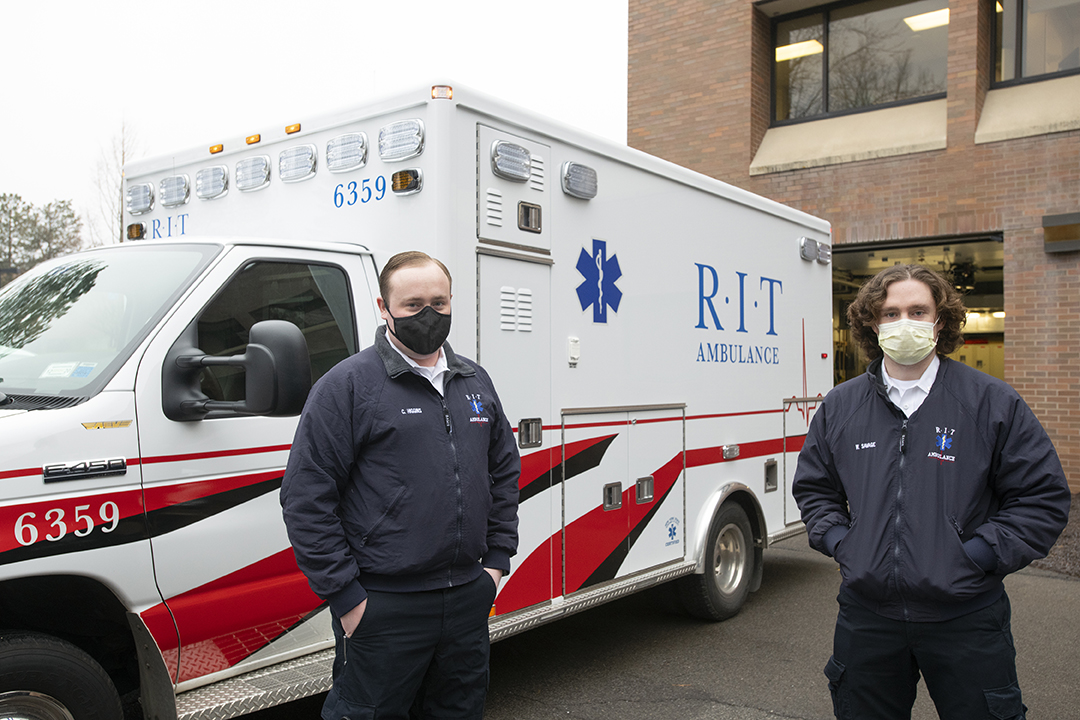Answering the call during the COVID-19 pandemic
RIT Ambulance crew members suit up with PPE to help prevent the spread of the virus
A. Sue Weisler
RIT Ambulance’s Chief of Operations, Cameron Higgins, left, and President William Savage, say ambulance service remains in force on the RIT campus during the COVID pandemic.
Members of RIT Ambulance this academic year have continued to answer 911 calls on the RIT campus all while taking additional precautions to prevent the spread of the COVID-19 virus.
They responded to simple traumas, such as patients falling off a bike, falling out of bed, hitting their head or an allergic reaction. They also transported students to quarantine locations.
RIT Ambulance follows county and state guidance for all EMS agencies in the state. If they are called to a suspected COVID case, crew members wear personal protective equipment, including masks, eye protection, gloves and an isolation gown. Once the patient is transported to a hospital, the PPE is changed, the stretcher is decontaminated and the entire back and commonly touched areas of the ambulance is sprayed with disinfectant.
Cameron Higgins, RIT Ambulance’s chief of operations, said RIT Ambulance responded to 302 calls in 2020, down from the typical 500 to 600. He credits the decline to the amount of time the campus was closed in the spring as well as fewer faculty and staff working on site.
“And people were more cautious going to the hospital about minor injuries,” he said. “Instead of sitting in the ER for a few hours with a broken finger, maybe they’d go to urgent care or see their primary doctor.”
Higgins, a fourth-year biology major from Morgantown, Pa., said about 50 students are members of RIT Ambulance, either as drivers, medics, or crew technicians. Although they try to have people on-call 24 hours a day, their primary shifts are 6 p.m. to 11 p.m. and 11 p.m. to 6 a.m.
“Anybody can call 911 at any time,” he said. “If we don’t have somebody who is on shift, we call around to our members to see who is available. If they can jump on the call, they run to the base. There are usually people always at the base doing homework or talking with friends.”
Ambulances from other agencies are also able to respond to campus, and likewise, RIT Ambulance can respond to calls off campus by other agencies for car accidents, fires and other trauma if needed.
RIT Ambulance President William Savage, a fourth-year computer science major from Westborough, Mass., joined the ambulance in his freshman year.
“I was looking for a community,” he said. “I was in track and Scouts at home. And the ambulance sounded like something I’d really like. I’ve learned a lot going through my EMT training.”
Another recent change when responding to a possible COVID patient is limiting the number of people who get close to them. In the past, the driver would help by bringing equipment to the patient.
“Every time we go into a call, we walk into the room and talk with the patient,” Savage said. “If there’s a concern about COVID, sometimes the driver stays at the door. We’re trying to reduce our exposure and the number of people on the scene.”
Higgins said the precautions have helped control the spread of the virus. And several members have already received their COVID vaccines along with EMS personnel from other agencies in the county. He said the experience with the ambulance has helped him decide to do something in the medical field after graduation, whether it be going to medical school, working as a paramedic, “or wherever the road may take me.”
Savage said additional volunteers are always welcome, and no prior experience is necessary. Applications can be found on the RIT Ambulance website.
But what is more important, he said, is for the RIT community to know that RIT has an ambulance and is a free resource.
“We’re here and we’re available so people should know they are safe,” Savage said. “And we’re all looking forward to the end of COVID.”




